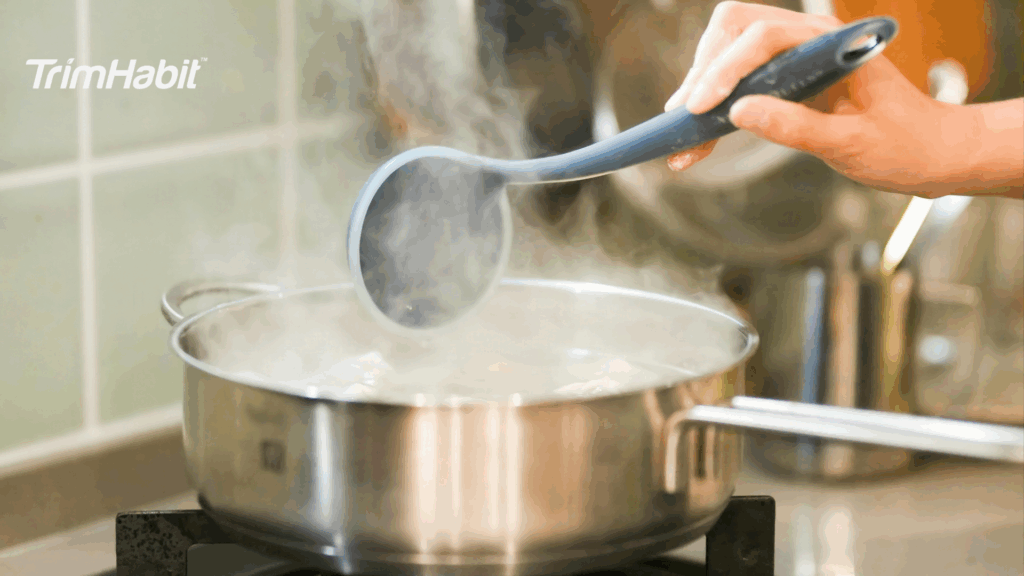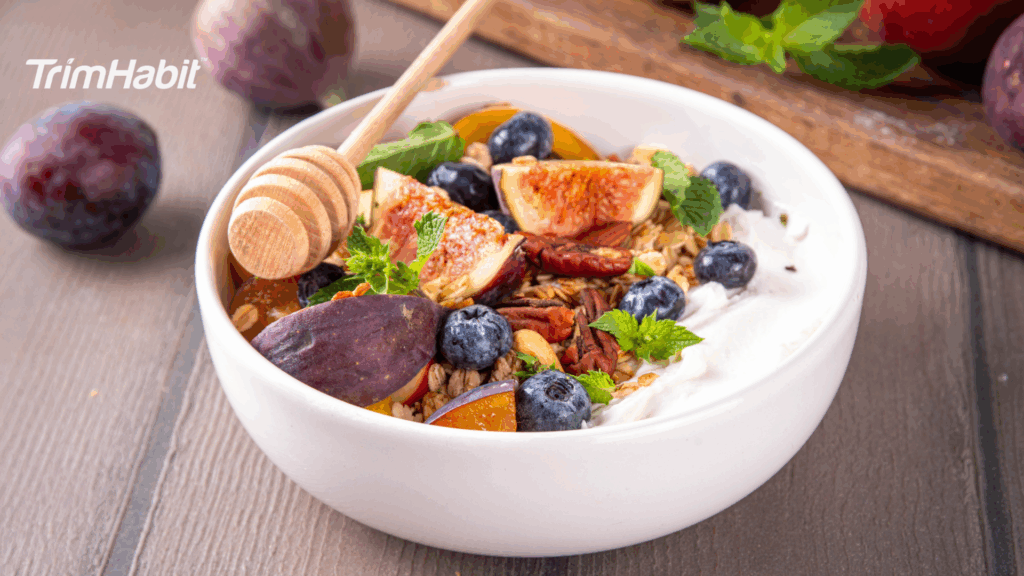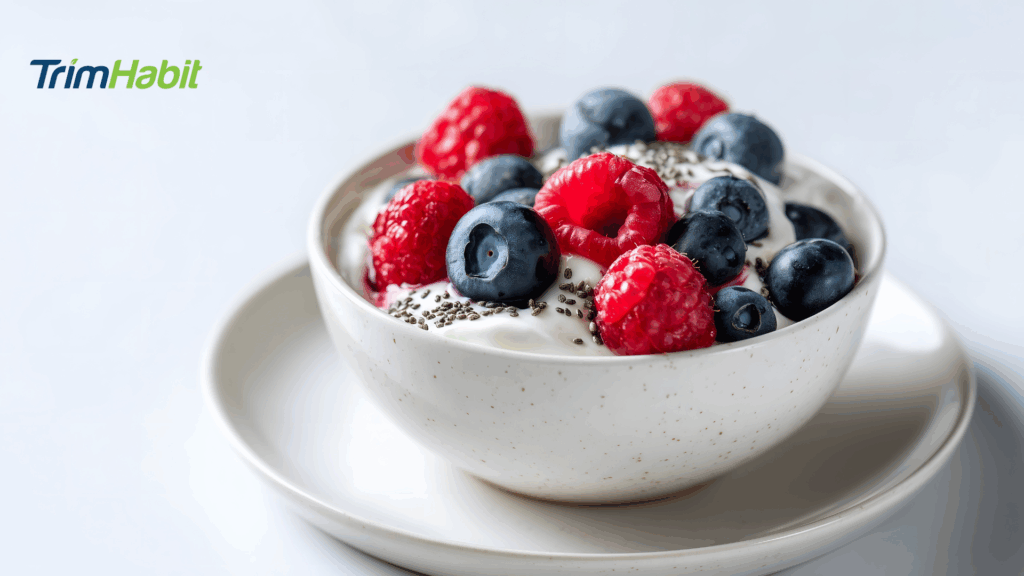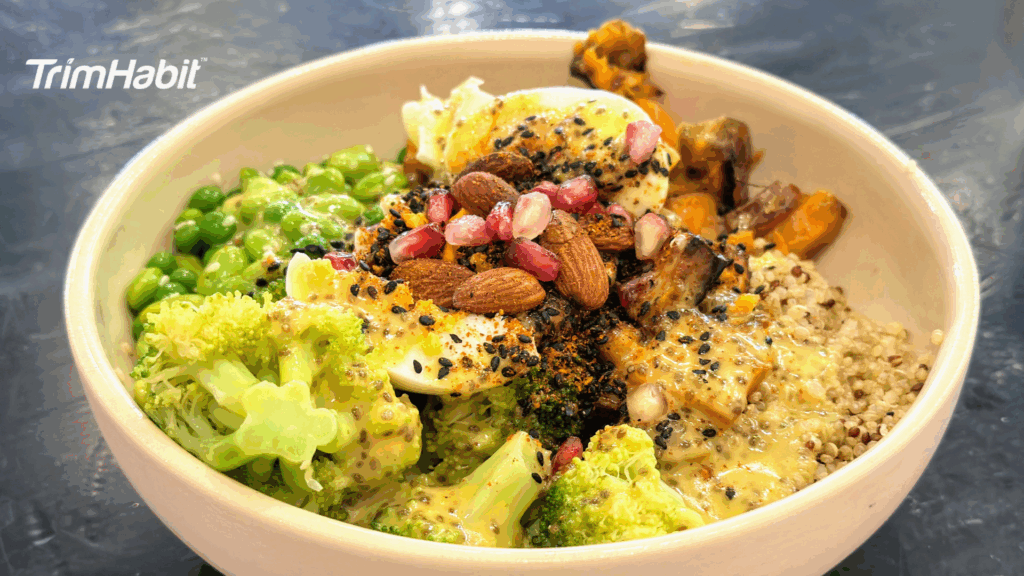When you’re taking semaglutide for weight loss or blood sugar control, your eating habits may need some adjustment. This FDA-approved medication reduces appetite and slows digestion, which makes portion-controlled, nutrient-dense, and easy-to-digest meals especially important.
Still, preparing every meal from scratch is not always realistic. In busy moments, healthy frozen meals can be a practical solution if you choose the right ones.
In this article we’ll guide you through the best frozen meals that pair well with semaglutide, support weight loss, and offer balanced nutrition so you can stay on track even on your busiest days.
Semaglutide Overview
Semaglutide is a medication originally developed to manage type 2 diabetes, but it’s now widely used for weight loss as well. It mimics a natural hormone called GLP-1 (glucagon-like peptide-1), which helps regulate blood sugar, slow digestion, and reduce appetite1.
How It Works
- Appetite Suppression: By acting on brain receptors, semaglutide helps reduce hunger and increase feelings of fullness.
- Slower Gastric Emptying: It slows how quickly food leaves the stomach, stabilizing blood sugar and prolonging satiety.
- Improved Insulin Secretion: It encourages the pancreas to release insulin when blood sugar levels are high.
Benefits
- Weight Loss: Many people lose significant weight while taking semaglutide, especially when combined with diet and lifestyle changes. Regular exercise can further maximize weight loss and overall health benefits.
- Blood Sugar Control: Helps lower A1C levels and reduce fasting blood glucose.
What To Look for In A Semaglutide-Friendly Frozen Meal
Finding frozen meals that align with your semaglutide journey doesn’t have to be complicated. The right choices can keep you full, support your digestion, and help you stay on track with your health goals. It’s important to check the nutritional content of frozen meals to ensure they fit your specific health and dietary goals.
Here’s a checklist of what to look for on the label:
Protein-Packed (15g or more)
Protein is key to keeping you full between meals and preserving muscle as you lose weight; always check the protein content on the label to ensure the meal meets your needs. Look for meals featuring lean meats, tofu, legumes, or eggs.
High in Fiber (5g or more)
Fiber works alongside semaglutide to improve digestion and blood sugar stability. Great sources include green beans, beans, lentils, whole grains, and vegetables.
Complex Carbs Only
Skip meals loaded with white rice, refined pasta, or sugary sauces. Instead, choose meals with quinoa, brown rice, sweet potato, or whole grains.
Moderate Sodium (ideally <600mg)
Many frozen meals are high in salt, but too much sodium can lead to bloating and water retention. Check the label and aim for lower-sodium options.
Opt for low-sodium soy sauce instead of regular or salty condiments if you want to add extra flavor to your frozen meals.
Low Added Sugar (ideally <5g)
Added sugars can lead to blood sugar spikes and crashes, which semaglutide works to prevent, especially when avoiding added sugars. Avoid sweet glazes, fried foods, or hidden sugars in sauces.
Balanced Calories (around 300–450)
Semaglutide reduces appetite, so smaller portions are often enough. However, meals should be nutrient-dense to provide energy and satisfaction for sustainable weight loss.
Simple, Whole Ingredients
Choose meals that use real, recognizable ingredients without a long list of additives. Fewer preservatives = less stress on your digestive system.
The Best Frozen Meals That Pair Well With Semaglutide
When you’re taking semaglutide, every bite counts. This medication slows digestion and lowers appetite, which means your meals need to be efficient, nourishing, and easy to tolerate. Frozen meals can be a reliable option, especially on days when time or energy is limited. Choosing frozen meals that support your body without triggering nausea or bloating makes it easier to stay consistent.
Below is a list of frozen meal types that support weight loss, healthy digestion, and steady energy while you’re on semaglutide.
1. Healthy Choice Power Bowls
Why it works: Packed with lean protein, whole grains, and veggies.
Popular option: Adobo Chicken Bowl
Nutrition: 350 calories, 20g protein, 5g fiber
Bonus: No artificial preservatives.
2. Evol Balance Bowls
Why it works: Great for balanced macros and minimal added sugars.
Popular option: Grilled Chicken with Quinoa and Vegetables
Nutrition: 330 calories, 20g protein, 4g fiber
3. Amy’s Light & Lean Meals
Why it works: Black beans are vegetarian-friendly, low in sodium, and made with clean ingredients. They are also a great ingredient for healthy breakfast options, such as breakfast burritos with whole-grain tortillas and fresh herbs.
Popular option: Light in Sodium Black Bean & Cheese Enchilada
Nutrition: 260 calories, 13g protein, 5g fiber
4. Trader Joe’s Miso Salmon Bowl
Why it works: Anti-inflammatory omega-3s + fiber-rich veggies.
Nutrition: Around 400 calories, high in protein and heart-healthy fats.
5. Kashi Sweet Potato Quinoa Bowl
Why it works: Plant-based, fiber-dense, and filling.
Nutrition: 300 calories, 9g protein, 7g fiber
Great for: Vegetarian or flexitarian eaters on semaglutide.
6. Real Good Foods Chicken Lasagna Bowl
Why it works: High protein and low-carb; good for blood sugar balance.
Nutrition: 280 calories, 25g protein, low net carbs
7. Tattooed Chef Plant-Based Meals
Why it works: Whole-food ingredients, often grain- and gluten-free.
Try this: Veggie Hemp Bowl
Nutrition: 350 calories, 10g protein, 6g fiber
Quick Tips When Shopping
- Look for 15–25g protein per serving
- Choose meals with 5g+ fiber
- Avoid added sugars, fried items, and creamy sauces
- Stick to 300–450 calories per meal for sustainable energy
Using balanced recipes as inspiration can also help you choose the best frozen meals for your needs.
What To Avoid In Frozen Meals While On Semaglutide
While semaglutide supports appetite control and blood sugar balance, certain frozen meals can work against you. Heavily processed options may leave you feeling bloated, nauseated, or sluggish. Choose meals made with real, whole ingredients to help your body feel lighter and more stable after eating.
Here are the ingredients to look for and the ones to avoid when checking frozen food labels to support your health while on semaglutide:
High in Saturated Fat
Too much saturated fat can further slow digestion and contribute to nausea or GI discomfort.
Avoid: Meals with creamy sauces, cheese-heavy dishes, fried items, or fatty cuts of meat.
Low Protein (<10g)
Protein is essential for satiety and muscle maintenance, especially when your appetite is suppressed.
Avoid: Carb-heavy meals with little to no protein, like plain pasta, rice bowls without meat or legumes, or veggie-only options without protein boosters.
Low Fiber (<3g)
Low-fiber meals won’t keep you full and may lead to constipation, a common side effect of semaglutide.
Avoid: White rice, white pasta, or meals lacking vegetables or whole grains.
High in Added Sugars
Added sugars can spike your blood sugar and work against semaglutide’s blood sugar-stabilizing effects.
Finding alternatives like grilled vegetables or lean proteins can be a practical solution. Avoid glazed sauces, sweet and sour meals, teriyaki with added sugar, or “sweet chili” or anything else.
Excessive Sodium (>700mg)
Too much sodium contributes to bloating and can raise blood pressure, especially when eating smaller meals more often.
Avoid: Processed frozen pizzas, burritos, or meals with salty sauces and preservatives.
Ultra-Processed Ingredients
Highly processed additives can irritate the gut or make meals harder to digest while on semaglutide.
Avoid: Long ingredient lists with artificial preservatives, colorings, MSG, or hydrogenated oils that can affect public health.
Oversized Portions
Large meals can overwhelm your slowed digestion and trigger nausea.
Avoid “Family size” trays or extra-large single-serving meals that are over 500 calories or more than half your daily calorie intake.
Tip: When in doubt, flip the box and read the nutrition label + ingredients list. A shorter list of whole, recognizable foods usually signals a better fit for your semaglutide-friendly plan.
Tips For Making Frozen Meals Even Better
Frozen meals are convenient but with a few simple tweaks, you can turn them into more satisfying, gut-friendly options that work with semaglutide, not against it. Here’s how to boost the nutrition, flavor, and digestibility of your favorite frozen dishes by following package instructions:
Add Fresh Veggies
Extra fiber helps digestion and keeps you full longer. Try:
- Steamed spinach, broccoli, or zucchini
- Fresh spinach leaves, a handful of arugula, or baby kale added post-microwave
- Riced cauliflower or shredded cabbage for volume
Boost the Protein
Many frozen meals fall short on protein. Adding a little extra can support fullness, lean muscle maintenance, and strength training. Try:
- A soft-boiled egg or poached egg on top
- Cottage cheese or plain Greek yogurt on the side
- A few slices of grilled chicken, tofu, beans, or kidney beans
Add Healthy Fats (In Moderation)
Semaglutide slows digestion, so stick with small portions of healthy fats for your overall health that won’t overwhelm your gut. Try:
- ¼ avocado sliced on top
- A drizzle of olive oil, sesame oil, or tahini
- A sprinkle of hemp or chia seeds
Brighten It Up with Flavor
Frozen meals can taste dull. A few fresh ingredients can elevate the meal and aid digestion.
Try:
- A squeeze of lemon or lime
- Fresh herbs like parsley or cilantro
- A dash of turmeric, paprika, or black pepper
Watch the Heat Time
Overcooking can make frozen meals rubbery or soggy, underwhelming in taste and texture.
Tip:
- Undercook for 30 seconds, stir, then finish heating.
- Let it sit for a minute after microwaving for better consistency.
Hydrate
Semaglutide can cause mild dehydration and constipation. Pairing your meal with fluids helps your body digest better.
Try:
- A glass of water with lemon or cucumber
- Herbal tea like ginger, mint, or chamomile
With a few simple upgrades, frozen meals can become more nourishing, more satisfying, and easier on your digestion. This makes them a better fit for semaglutide and your weight loss efforts.
Final Thoughts
Eating while on semaglutide doesn’t mean you have to give up convenience or flavor. The right frozen meals can support weight loss, help manage blood sugar, and leave you feeling better throughout the day. The most important part is choosing options with enough protein, fiber, vegetables like cherry tomatoes, and a reasonable amount of calories, all while being gentle on your stomach.
From brand suggestions to smart label tips, this guide has shown that frozen meals don’t have to be your last resort. With a little planning and a few fresh add-ons, they can be a regular part of your routine.
Healthy eating doesn’t need to be complicated. Keep it simple, make smart choices, and let your frozen meals work for you.









